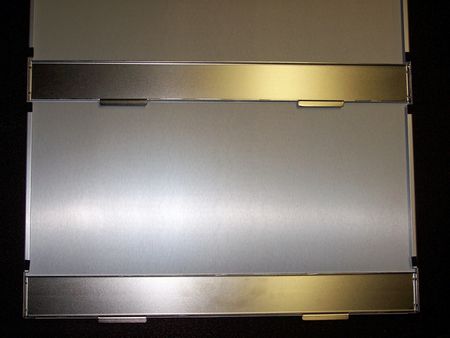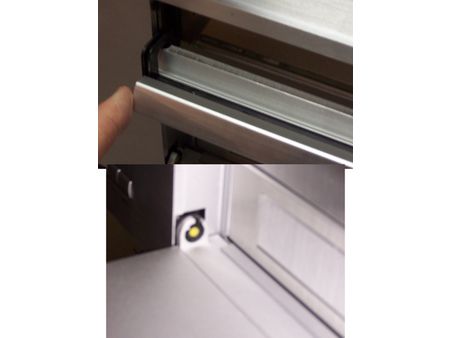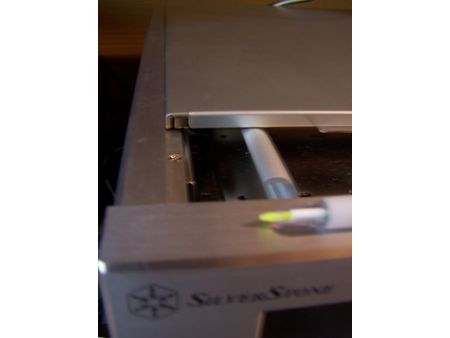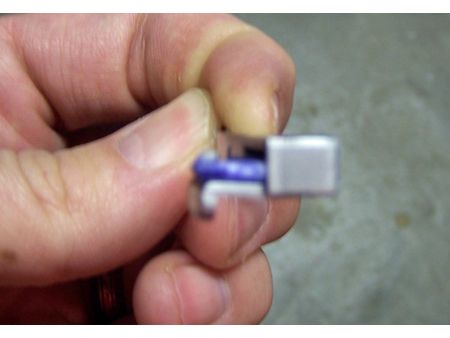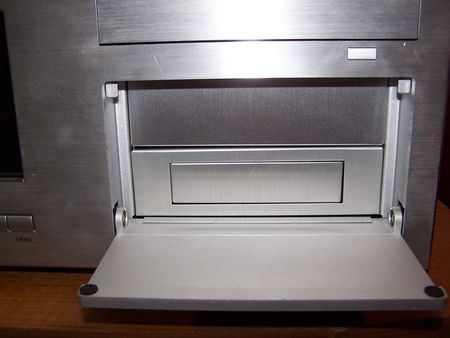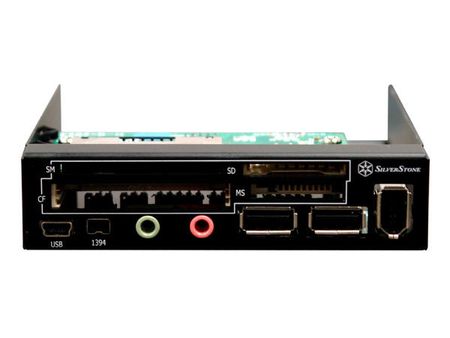Silverstone Crown CW03 HTPC Case
The Case
The case
The next thing you most likely will notice is the quality of the case. It measures 16.9" W x 17.2" D x 7.2" H (43 cm x 43.6 cm x 18.4 cm). It is an aluminum case and still weighs in at 17.64 lbs (8 kg). The weight is partially due to its size and the thickness of the aluminum used, but also due to the nickel-coated steel support for reinforcement.
The front panel is mostly aluminum, except for the display and some small plastic parts.
The case’s aluminum parts are inlayed into each other to give a better finish and greater strength.
When asked, Silverstone indicated that this was one of the toughest cases to build, and so production was only about 80 per day. This is quite low, given that some vendors crank out thousands of cases per day, and would explain why there are sometimes shortages of the unit.
The drive doors
The optical drive door does a nice job of concealing the standard 5¼" optical drive. It is fully integrated into the front panel and includes a small pushbutton below the door. The button has one major flaw: it can rise above the optical drive’s eject button. This is because it is one of the plastic parts, and is hollow behind the actual case button. This proved to be an issue for the Pioneer Blu-Ray drive we installed.
To solve this issue, Silverstone includes some rubber pads to increase the surface area and allow the button it to press the eject button on the Blu-Ray drive. It did not work, though — the pads popped off easily, and the case eject button would become stuck on the drive eject button. The solution that did work was to take an old case badge — the thick plastic kind with self-adhesive on the back — and cut it to size, then stick it into the hollow space behind the removed eject button. This was an easy fix and worked very well. Silverstone could implement it just by filling in the space behind the button all the way to the end of the part.
There is also a minor issue when the case optical door is open; it blocks the case’s eject button. This means that you will have to gently press the drive itself to close the drive, while some people prefer to use the eject button instead.
Get Tom's Hardware's best news and in-depth reviews, straight to your inbox.
The CW03 case has two more 5¼" drive bays below the built-in optical drive. There is a very high quality door covering these, nicely balanced to prevent it from just flopping open. It is made of thick aluminum and is nicely finished, so it really does fit in well with a high-end home theater.
The bay can support not only 5¼" drives but also includes a 3½" adapter made of the same high quality aluminum. This then becomes the ideal place to add front panel connections via either a 5¼" or 3½" bay device. I would suggest the Silverstone FP34 in the matching aluminum so that you can continue the smooth look of your case. The FP34 provides card reading capabilities, 2 USB A, 1 USB mini 5 pin, 1 IEEE-1394 6-pin, 1 IEEE-1394 4-pin, and one each of audio and microphone.
This would be hidden behind the large swing door, but still gives you the ability to read media cards and connect USB and IEEE1394 devices.
The feet on this unit are of high quality aluminum, with large rubber inserts to prevent the case from sliding around. The feet are 2.25" (5.7 cm) in size, and rotate with just slight pressure. There are five feet: four on the corners and one in the middle of the case. This provides a very good feel when the case is placed on any surface — there is little chance that this case is just going to slide onto the floor by accident.
To test the look of this case as a piece of home theater or A/V equipment, I asked five people to look at the Crown CW03 in a home theater setup. They were all immediately impressed with the LCD display. They all asked if it was a touchscreen and started touching the screen. They immediately thought this was a very high-end piece of equipment but did not think it was just a receiver or amp. They knew it was something more.
-
Jakt It's a good review of a case, but it's a bit misleading to title page 5 "Making an HTPC". Making a good HTPC involves a lot more than slapping some good componenents inside a spiffy HTPC case. Readers interested in "Making an HTPC" would benefit from a discussion of video capture cards, cpu cooling fans, hard drives (cooler and quieter, and discrete pvr drives that are seperate from the OS hd), video cards (passive cooling!) and even pvr software, such as Windows Media Center, BeyondTV, Myth TV, or others.Reply
Maybe I didn't read carefully enough, but I didn't see what the street price of this case is. Also, are there competitive alternatives worth considering?
I'm not here to shoot this article down, but I was hoping to see some of these issues addressed after reading 7 pages.
Th -
TeraMedia For anyone building an HTPC with this case, they would probably want cooler, larger HDDs. The GP series from WD would be better for that.Reply
The CPU and GPU are probably overkill unless the person using this is an avid gamer.
You did not say much about the touchscreen and how it works with Vista's built-in Media Center software. You stated that the instructions say to set it up as the secondary display in an extended configuration. Does the touchscreen echo the information in Vista's MC? Or did you use iMedian? -
BillLake I actually used Vista MC, iMedian and the HDMedian also. They all have their benefits and weaknesses. When connected to the big TV, I used Vista MC, it worked better for me with the remote, when connected to a local LCD the others worked better as they really like the use of the touch screen. Going back and forth was easy with the software, sorry I did not put more on that in the article but I wanted to keep it more about the case than software because that can be tweaked and changed. I can say when connected to my big TV, I really like the little LCD show one thing and maybe have something else on the TV. Kind of like Picture in a picture.Reply
As far as more on HTPC, check out Tom's other articles as there are several and this was just about this case. You can compare them there, same for the software as there are articles on that too. As for the cost of this case, they usually use the search engine to provide that but just google it and you will find prices running about $699. http://www.google.com/products?q=silverstone+CW03&rls=com.microsoft:*&ie=UTF-8&oe=UTF-8&um=1 -
resonance451 I've been building MicroATX HTPC's, and find them just as quiet and operational, and a lot cheaper, even with adding a screen (and why would I even want that, as I've got a 56" 1080p HDTV?!)Reply -
Jakt I have an Ahanix mce701 (not sure if they make them anymore) for my htpc. Very similar to the Silverstone, but not the same high level of quality. At less than half the price, I am extremely satisfied with the Ahanix. The touchscreen is wonderful for doing everything that the television isn't needed for, such as selecting and playing music, catching the latest weather forecast, or simply looping a slideshow of the kids while it's idle. The screen also adds a certain geek-cool touch to my entertainment center. I keep my components at eye-level, but if it were stacked below the tv, I could see the benefits of the little touchscreen greatly diminished.Reply -
While this article is fine for reveiwing the case itself, it really falls short on the build aspect. Tom's Hardware is far too long overdue for an updated HD HTPC build. It seems like they are focused just on gaming. With DVD recorders with built in HDD's pretty much banned in the U.S., HTPC's are really becoming popular.Reply
-
wcrank I have a Coolermaster CM Media 282, you can use 4 120mm fans in this case. Its not the most stylish, but with Noctua 120mm fans it is exceptionally silent (due to the position of the fans I run passive cooling on an EVGA 8600 gt GPU, & AM2 5200 CPU). Plus I built this system for probably the cost of the silverstone case... Not a power house system, it is only a PVR.Reply -
BillLake boysdaddy: I used the stock cooler on the Q6600. I thought it was very quiet even under load and was impressed with it. It is not a highend cooler but I did not have time to do much more.Reply
niknik, I was going to do a Blu-Ray drive with some results of it but the Pioneer blu-ray software did not work, it said not a supported pioneer system and then the replacement did the same. I am investigating it further before I say any more but I think an HD HTPC system is a good idea.
I build a PVR on the KPC system like I reviewed, it works great, is quiet and I spent less than $400 on it
